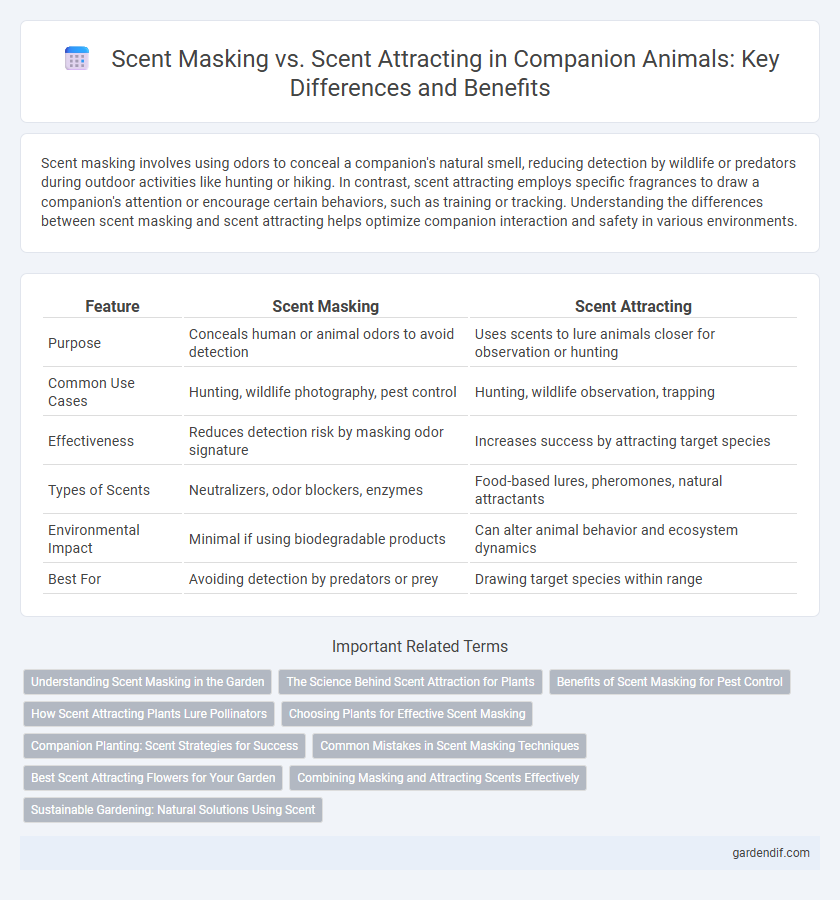
Scent masking vs Scent attracting Illustration
Scent masking involves using odors to conceal a companion's natural smell, reducing detection by wildlife or predators during outdoor activities like hunting or hiking. In contrast, scent attracting employs specific fragrances to draw a companion's attention or encourage certain behaviors, such as training or tracking. Understanding the differences between scent masking and scent attracting helps optimize companion interaction and safety in various environments.
Table of Comparison
| Feature | Scent Masking | Scent Attracting |
|---|---|---|
| Purpose | Conceals human or animal odors to avoid detection | Uses scents to lure animals closer for observation or hunting |
| Common Use Cases | Hunting, wildlife photography, pest control | Hunting, wildlife observation, trapping |
| Effectiveness | Reduces detection risk by masking odor signature | Increases success by attracting target species |
| Types of Scents | Neutralizers, odor blockers, enzymes | Food-based lures, pheromones, natural attractants |
| Environmental Impact | Minimal if using biodegradable products | Can alter animal behavior and ecosystem dynamics |
| Best For | Avoiding detection by predators or prey | Drawing target species within range |
Understanding Scent Masking in the Garden
Scent masking in the garden involves using specific plants or substances to conceal or alter odors that attract pests, thereby protecting companion plants from damage. Essential oils like peppermint or garlic emit strong fragrances that disrupt pest detection and reduce infestations. Understanding scent masking empowers gardeners to create healthier ecosystems by minimizing pest-related stress without relying on chemical pesticides.
The Science Behind Scent Attraction for Plants
Plants use chemical signals to attract specific animals or insects for pollination and seed dispersal, releasing volatile organic compounds (VOCs) that mimic pheromones or food sources. Scent attracting is a targeted evolutionary strategy where distinct compounds trigger sensory receptors in pollinators, enhancing reproductive success. In contrast, scent masking involves neutralizing or overpowering these signals to deter unwanted herbivores or competition, thereby protecting the plant's survival.
Benefits of Scent Masking for Pest Control
Scent masking effectively conceals human and pet odors to deter pests such as rodents, insects, and wildlife from entering living spaces, reducing the risk of infestations and damage. By disrupting pests' ability to detect attractants, it minimizes the use of harmful chemicals and promotes a safer environment for households and pets. This method enhances pest control strategies by offering a natural, non-toxic solution that complements other preventive measures.
How Scent Attracting Plants Lure Pollinators
Scent attracting plants release specific volatile organic compounds that are highly effective in luring pollinators such as bees, butterflies, and moths by mimicking the natural odors these insects prefer. These aromatic signals play a crucial role in pollination ecology by enhancing plant reproductive success through increased pollinator visits. Understanding the chemical profiles of these attractant scents can optimize companion planting strategies to improve crop yield and biodiversity.
Choosing Plants for Effective Scent Masking
Selecting plants with strong, pungent natural odors like lavender, rosemary, and mint enhances scent masking by overpowering unwanted animal or insect scents. These plants emit volatile organic compounds that disrupt scent trails, reducing detection by pests or predators. Incorporating dense, aromatic foliage strategically around companion animals increases the effectiveness of scent masking in outdoor environments.
Companion Planting: Scent Strategies for Success
Companion planting leverages scent masking by using aromatic plants like basil and marigold to confuse pests, effectively reducing damage to vulnerable crops. Scent attracting involves planting flowers such as nasturtium or dill to draw beneficial insects that prey on harmful pests, boosting natural pest control. Employing strategic scent combinations enhances garden health and productivity by balancing repellent and attractive aromas for optimal pest management.
Common Mistakes in Scent Masking Techniques
Common mistakes in scent masking techniques include applying overly strong or unnatural scents that may alert rather than confuse animals, and failing to consider environmental factors such as wind direction and humidity that can impact effectiveness. Using synthetic products without testing their longevity often results in scent traces that dissipate too quickly or blend poorly with natural odors. Additionally, neglecting to mask human scent thoroughly around the companion's area can inadvertently attract curious wildlife instead of deterring them.
Best Scent Attracting Flowers for Your Garden
Scent attracting flowers such as lavender, jasmine, and honeysuckle create a fragrant environment that draws pollinators like bees and butterflies, enhancing garden biodiversity. These floral scents can also deter pests by masking less appealing odors, making them effective in companion planting strategies. Choosing aromatic blooms that thrive in your local climate ensures a thriving garden ecosystem with vibrant, natural scent attractants.
Combining Masking and Attracting Scents Effectively
Combining scent masking and scent attracting techniques enhances companion training by reducing unwanted odors while emphasizing desirable stimuli that guide behavior. Effective use involves layering neutralizing agents with targeted attractants, creating an olfactory balance that minimizes distraction and promotes engagement. Strategic application of these scents improves response accuracy and strengthens the bond between companion and handler.
Sustainable Gardening: Natural Solutions Using Scent
Scent masking in sustainable gardening uses natural plant fragrances to obscure harmful odors, reducing pest attraction and promoting a healthier ecosystem. In contrast, scent attracting leverages specific floral or herbal aromas to lure beneficial insects like pollinators and natural predators, enhancing plant health and biodiversity. Utilizing plants such as lavender for masking and marigolds for attracting offers eco-friendly pest control and supports organic gardening practices.
Scent masking vs Scent attracting Infographic

 gardendif.com
gardendif.com